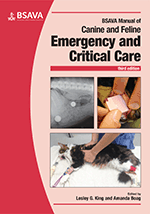
Full text loading...

Many animals with orthopaedic injuries or wounds also have injuries to vital organ systems. While potentially life-threatening problems are a priority, temporary and emergency management of wounds and fractures should not be ignored. This chapter describes the emergency treatment of wounds, including burns, and musculoskeletal trauma.
Acute management of orthopaedic and external soft tissue injuries, Page 1 of 1
< Previous page | Next page > /docserver/preview/fulltext/10.22233/9781910443262/9781910443262.17-1.gif

Full text loading...














